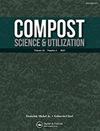中子- γ分析在堆肥碳氮比测定中的应用
IF 0.9
4区 农林科学
Q3 ECOLOGY
引用次数: 4
摘要
本文将讨论脉冲快/热中子分析(PFTNA)在测定堆肥碳氮比(C/N)方面的可能应用。与传统的化学分析相比,这种分析方法有几个优点,包括它是一种无损的原位方法,不需要大量的样本收集,并且可以分析更大体积的材料(~1 m3)比传统化学分析(~1 cm3)。碳的含量可以通过用中子照射堆肥并测量能量为4.44的伽马射线峰值来确定 由于非弹性散射而出现的MeV。氮可以通过测量10.83处的伽马射线峰值来确定 由于热中子捕获而出现的MeV。对于C/N测量,应首先构建一条将C/N质量比与碳/氮伽马峰比相关的校准线;我们的校准线是使用碳-硝酸铵混合物构建的。然后使用PFTNA测量来确定碳和氮的峰值,以便利用校准线来计算C/N质量比。这种方法的可操作性已在实验室实验中得到证明。PFTNA在堆肥C/N比测定中的适用性通过大型堆肥体积中中子传播的蒙特卡罗计算机模拟(Geant4工具包)和真实堆肥的实验测量(体积1.3 m3)。来自计算机模拟和实验的数据表明,PFTNA方法完全适用于确定堆肥材料中C/N比,最高可达25甚至更高。本文章由计算机程序翻译,如有差异,请以英文原文为准。
Application of Neutron-Gamma Analysis for Determining Compost C/N Ratio
Abstract The possible application of Pulsed Fast/Thermal Neutron Analysis (PFTNA) for determining the carbon-to-nitrogen ratio (C/N) of compost will be discussed. This analysis method has several advantages over traditional chemical analysis, including that it is a nondestructive in situ method that does not require extensive sample collection and it analyzes much larger volumes of material (∼1 m3) than traditional chemical analysis (∼1 cm3). The amount of carbon can be determined by irradiating compost with neutrons and measuring the gamma ray peak at an energy of 4.44 MeV that appears due to inelastic scattering. Nitrogen can be determined by measuring the gamma ray peak at 10.83 MeV that appears due to thermal neutron capture. For C/N measurements, a calibration line that relates the C/N mass ratio to the carbon/nitrogen gamma peak ratio should first be constructed; our calibration line was constructed using carbon–ammonium nitrate mixtures. PFTNA measurements were then used to determine carbon and nitrogen peak values in order to utilize the calibration line for calculating the C/N mass ratio. The workability of this methodology has been demonstrated in laboratory experiments. The applicability of PFTNA for compost C/N ratio determinations was evaluated with Monte Carlo computer simulations of neutron propagation in large compost volumes (Geant4 toolkit) and experimental measurements of real compost (volume 1.3 m3). Data from computer simulations and experiments demonstrated that the PFTNA method is fully applicable for determining the C/N ratio in compost material up to values of 25 and even greater.
求助全文
通过发布文献求助,成功后即可免费获取论文全文。
去求助
来源期刊

Compost Science & Utilization
农林科学-生态学
CiteScore
4.10
自引率
0.00%
发文量
0
审稿时长
>36 weeks
期刊介绍:
4 issues per year
Compost Science & Utilization is currently abstracted/indexed in: CABI Agriculture & Environment Abstracts, CSA Biotechnology and Environmental Engineering Abstracts, EBSCOhost Abstracts, Elsevier Compendex and GEOBASE Abstracts, PubMed, ProQuest Science Abstracts, and Thomson Reuters Biological Abstracts and Science Citation Index
 求助内容:
求助内容: 应助结果提醒方式:
应助结果提醒方式:


